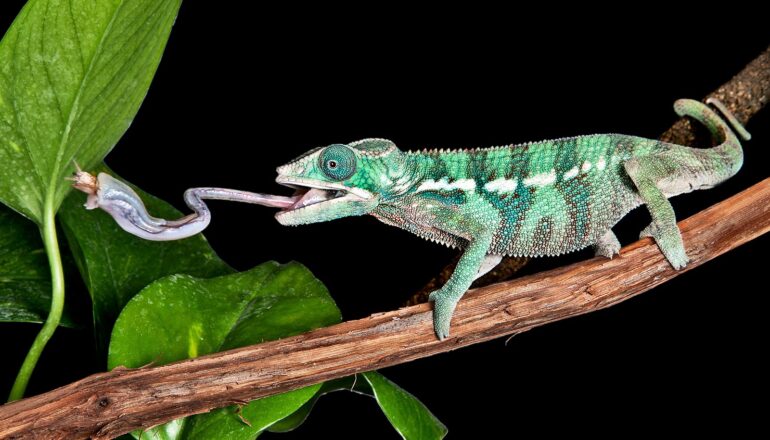Chameleons and salamanders launch their tongues in similar ways
- Researchers at the University of South Florida have discovered that chameleons and salamanders use the same underlying mechanism to launch their tongues at high speeds, despite living in different habitats.
- The study, published in Current Biology, reveals that both species developed a similar ballistic tongue-firing system using ordinary tissues, tendons, and bone, which has big engineering potential.
- The tongue mechanism works like a slingshot and can be scaled up or down, using soft or flexible materials, with possible biomedical applications such as devices to clear blood clots and tools for retrieving objects in hard-to-reach places.
- Biologists Yu Zeng and Stephen Deban are expanding their research to investigate how animal tongues project and retract with remarkable speed and precision, reflecting a growing movement in science called bioinspiration.
- The discovery has the potential to inspire new technologies and solutions for challenges on Earth and beyond, as nature has already solved these problems, and now scientists are learning how to adapt those solutions for human use.

The high-speed tongues of salamanders and chameleons are helping unlock engineering breakthroughs, researchers report.
Inside the Deban Laboratory at the University of South Florida, biology and engineering are colliding to reveal how nature’s designs could one day help solve challenges on Earth and beyond.
Postdoctoral researcher Yu Zeng and integrative biology Professor Stephen Deban’s most recent study reveals, for the first time, that salamanders and chameleons—though worlds apart in evolution—use the same underlying mechanism to launch their tongues at lightning-fast speeds.
The discovery, published in Current Biology, not only deepens our understanding of animal movement, but also points toward new potentials inspired by biology.
Chameleons and salamanders live in vastly different habitats—with chameleons living in warmer environments on trees or bushes and salamanders thriving in moist habitats, including in leaf litter and caves.
“They have actually never met each other in the wild,” Zeng says. And yet, Zeng and Deban found that both groups developed a remarkably similar “ballistic” tongue-firing system.
“They evolved the same architecture in their bodies to fire their tongues at high speed,” Zeng explained.
“What’s surprising is that they achieve this using the same ordinary tissues, tendons, and bone that other vertebrates have.”
For Deban, who has studied animal movements and physiology for more than three decades, bringing Zeng into his lab expanded the scope of his research into new, interdisciplinary territory. Zeng, who previously studied insect flight, brought a fresh perspective on how animals move through air and how those insights could translate to technology.
Video analysis, accumulated over more than a decade in Deban’s lab, shows that both salamanders and chameleons can project their tongues at speeds of up to 16 feet per second. The study is the first to place these species side by side and reveal a unifying mechanical model.
The tongue mechanism works much like a slingshot. That mechanism is what Deban and Zeng say has big engineering potential beyond the lab, into hospitals, disaster zones and even outer space.
“This mechanism can be scaled up or down, using soft or flexible materials,” Zeng says. “We’re already talking with engineers about possible biomedical applications, like devices that could clear blood clots. On a larger scale, it could inspire tools to retrieve objects in hard-to-reach places like a collapsed building or even grabbing debris in outer space.”
Deban and Zeng plan to expand their research to investigate how animal tongues not only project but also retract with remarkable speed and precision. Their work reflects a growing movement in science called “bioinspiration,” which refers to the development of novel materials, devices, or structures from solutions found in organisms.
“It is gratifying to have a unifying story about these amazing tongues, as well as potential engineering applications after so many years of focusing on the biology of these animals,” Deban says.
“Nature has already solved these problems, now we’re learning how to adapt those solutions for us.”
Source: University of South Florida
The post Chameleons and salamanders launch their tongues in similar ways appeared first on Futurity.
